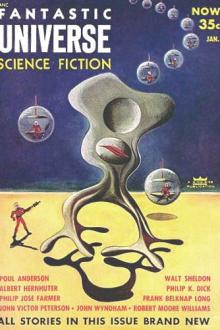The Fourth Child, Jessica Winter [fantasy novels to read txt] 📗

- Author: Jessica Winter
Book online «The Fourth Child, Jessica Winter [fantasy novels to read txt] 📗». Author Jessica Winter
Building trust.
Teaching love.
Valuing rage. Think of the unattached child’s rage as a fever. A fever must be treated, but it also must be understood as a cleansing reaction to a bigger threat—a fire that the body sets to smoke out danger. Rage is a rational response to the grief and pain caused by neglect and abuse, and under the right circumstances, it, too, can be cleansing. In the safe, controlled environment provided at Arden, the cathartic release of rage can break down the barriers the child has built against love and trust.
Reeducating the body. The body is a mosaic of cells. Those cells hold learning memories, and in each of those memories isa lesson, good or bad, about love, trust, and safety. The unattached child must, in a sense, unattach from her dream—or hernightmare—of the biological mother, and transfer her attachments to new caregivers. This is a physical process as much asit is a mental one. Elements of the Therapeutic Intensive
Breaking down defenses. The unattached child can be a citadel of deflection and controlling behavior. His defiance and disruptions may seem out of control, but in taking over his family’s lives, his oppositional behavior is also a means for him to stay in control. The therapist’s first task is to deconstruct those defenses through games, guided play, verbal correction, and othertechniques that are therapeutically designed to throw the child off balance.
“Baby”-ing. Another step in dismantling the child’s defenses is to guide her back to a state of infancy, where she feels both helplessand safe with a caregiver who is both all-powerful and nonthreatening. These techniques include swaddling, cuddling, cooing,and singing lullabies.
Role-playing. The child is guided toward reimagining traumatic incidents in his early life, unearthing memories that lead to the catharticrelease of rage and other emotions.
Holding therapy. Just as the infant must be protected from her own kick and startle reflexes through holding and swaddling, the unattached child can be shored up against her fear of touch and trust through holding therapy, where she again finds herself at once powerless and completely safe. During the two-week therapeutic intensive, holding therapy is the punctuation mark that ends a hard, fulfilling day of learning, unlearning, and relearning.
Rebirthing. This profound event grows organically out of holding therapy. It re-creates the child’s first and greatest embrace in thewomb: where her mother’s body holds her, safe and warm.
Lauren
Paula liked to talk about how different boys kiss. The senior, captain of the lacrosse team, who did it like he was slurpingsoup. The sophomore on the Model UN team, who thrust his stiff long tongue in and out, like a dowsing rod, “like he couldfuck with his mouth,” she said. When Paula described kissing, it was like she wasn’t one-half of the kiss. It was like theguys were sucking at the air or a mirror, and Paula was off to the side taking notes.
When she was having sex with a guy, Paula said, she would imagine him doing normal things—writing a term paper, standing inline at Mighty Taco. And sometimes when she saw a guy doing normal things, she would imagine him having sex. “But, like, it’sall normal,” Paula said to Lauren.
They were sitting across from each other at the big table in Tedquarters, sharing a bag of Doritos. “Why is it weird to havesex in front of people but it’s not weird to eat in front of people?” Paula asked. “They’re both totally regular, boring,gross sticky things that everybody does.”
“Not everybody,” Lauren said sheepishly.
“I mean, eventually,” Paula said.
Kurt Cobain was in one of Paula’s magazines with his girlfriend. He had cherry-red hair and an itchy blue cardigan; his girlfriendwas kissing him in profile, her lemony hair waxy and curling like a doll’s. “She’s ugly,” Paula said, and she was so happy about it. Paula loved Kurt Cobain, lately seemed to think about Kurt Cobain all the time, and could work Kurt Cobain into any conversation, much like Mom could with Father Steve. “I think Kurt goes out with her just to piss people off,” Paula said.
“Or maybe he goes out with her because they like each other,” Lauren said.
“I bet she weighs more than Kurt does,” Paula said. “Did you know he’s so skinny he wears long underwear under his clothes?To stay warm and pad himself out.”
Lauren had started to wonder whether Paula made up all her stories of sex with boys, or at least some of them; if she placedherself in their arms the same way she placed herself inside Kurt Cobain’s head as he picked out his clothes in the morning.
“Is Kurt Cobain an Asshole, a Creep, or an Unspeakable?” Lauren asked. Paula and Lauren had categories for all boys and men,famous or not. Assholes were usually extroverts, Creeps were introverts, and Unspeakables were unable to be fully comprehendedin their assholishness, their creepiness, and/or their dreamy perfection. Stitch Rosen was a Creep. Andy Figueroa was an Asshole,and so was Rajiv Datt, who was Stitch’s best friend. Assholes and Creeps tended to pair off with one another. Brendan Dougherty,a quiet junior, with his pale-blue eyes and choirboy singing voice, was an Unspeakable.
“Kurt Cobain is Unspeakable with Asshole tendencies,” Paula replied, swallowing the word asshole as Mr. Smith entered the room. Instead of heading toward his desk, Mr. Smith sat down at the big table, next to Lauren andacross from Paula. Their elbows touched for a moment.
“I would have guessed Unspeakable leaning toward Creep,” Lauren said.
“He’s an A-hole who wants you to think he’s a Creep,” Paula said.
“Wouldn’t you have to be a little bit of an A-hole to be the lead singer of a band?” Lauren said. She rustled





Comments (0)